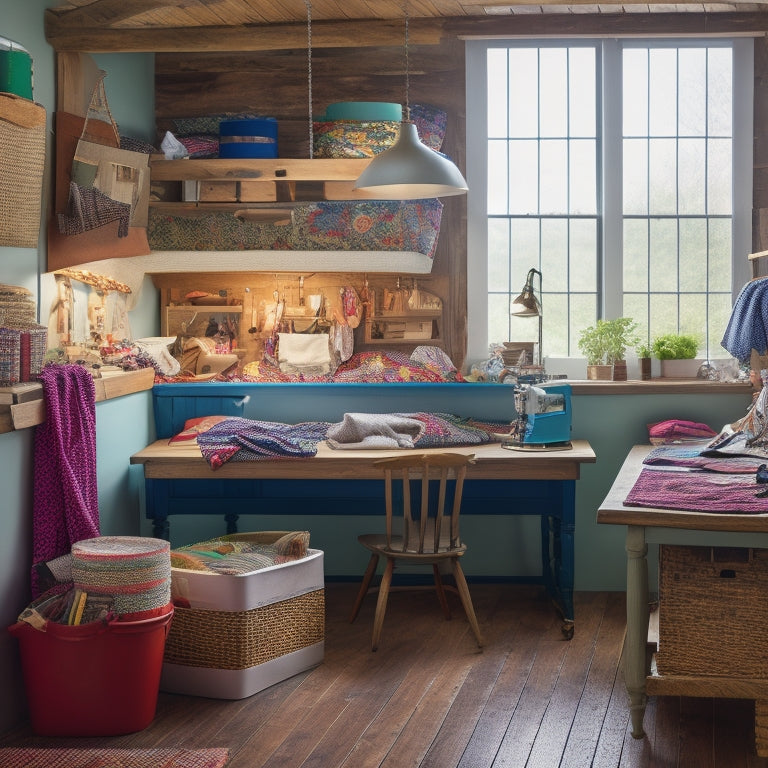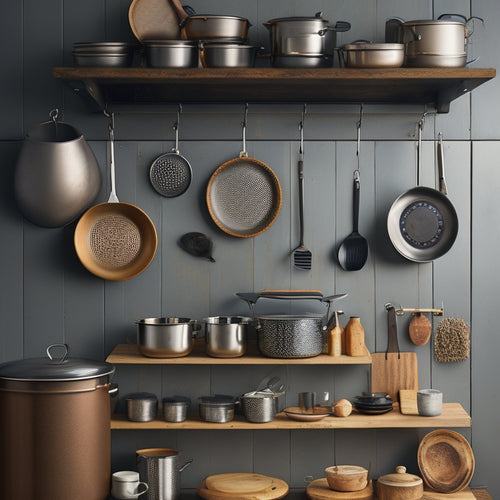
Revamp Your Sewing Room With Attic Transformation
Share
I immersed myself in my cramped and dusty attic transformed into a vibrant sewing haven, prioritizing safety and functionality. I tackled the narrow staircase, lack of insulation, and musty smell, replacing them with clever storage solutions, flexible workspaces, and an abundance of natural light. Strategically placed windows and light-colored walls amplify the morning sun's gentle rays, illuminating every stitch and seam. Custom cabinets and modular shelving units keep my fabric and supplies organized, while wheeled sewing cabinets and tables allow for effortless project rotation. Now, I'm ready to plunge into my next creative project - and I'm excited to share the secrets of my transformation with you.
Key Takeaways
• Prioritize attic safety by addressing narrow staircases, lack of insulation, and musty smells before renovating the sewing room.
• Maximize natural sunlight with strategic window placement, light-colored walls, and minimal obstructions for optimal ambiance and photos.
• Incorporate clever storage solutions, such as custom cabinets and fabric folding, to ensure easy access to supplies without clutter.
• Design a flexible workspace with wheeled sewing cabinets, modular shelving, and open floor space to adapt to shifting project needs.
• Create a well-designed layout that balances functionality and inspiration, ensuring a productive and enjoyable sewing experience.
Before the Attic Transformation
As I stood in the dimly lit, cramped attic space of my 90-year-old Oak Park home, I envisioned a sewing sanctuary that would burst with natural light and creative energy.
But first, I'd to tackle the attic's safety concerns. The narrow, rickety staircase and lack of insulation made it a hazardous space. I knew I'd to prioritize attic safety and address the insulation needs before I could even think about setting up my dream sewing studio.
The musty smell and dusty air only added to the sense of urgency. I took a deep breath, imagining the transformation that was to come, and began to plan the necessary renovations to create a safe and functional space that would soon become my happy haven.
Top Sewing Room Priorities
With my dream sewing studio finally taking shape, I'm homing in on the top three essentials that'll make this space truly functional and inspiring: natural sunlight, clever storage, and flexible furniture that can adapt to my ever-changing projects.
Here's a breakdown of my top priorities:
| Priority | Description |
|---|---|
| Natural Sunlight | Essential for photos and room ambiance |
| Clever Storage | Cabinets for fabric storage and organization |
| Flexible Furniture | Adaptable space for moving projects and furniture |
A well-designed sewing room layout is important to maximize productivity and creativity. By incorporating these three essentials, I'll be able to create a space that's both functional and inspiring. Proper fabric storage will keep my materials organized, while flexible furniture will allow me to adapt to changing project needs. With these priorities in place, I'll be able to create a sewing studio that truly supports my creative vision.
Designing for Natural Sunlight
I carefully position the new windows to capture the morning sun's gentle rays, flooding my sewing room with a warm, golden light that illuminates every stitch and seam.
As a sewer and photographer, I know how important natural sunlight is for capturing stunning photos of my projects. To maximize sunlight, I consider the following design elements:
- Strategic window placement to reduce harsh shadows and glare
- Light-colored walls and flooring to reflect and amplify natural light
- Minimizing obstructions, such as furniture and curtains, to guarantee an unobstructed view of the sun's path
Organizing With Cabinets and Storage
What's the secret to a serene and functional sewing room - one that lets me stay focused on my latest quilt project without getting bogged down in clutter and chaos? For me, it's all about clever storage solutions.
I've invested in custom cabinets that provide ample space for my fabrics, threads, and notions. Fabric folding is an art form in itself, and I've mastered the technique to maximize storage capacity. I can easily access my supplies without having to dig through piles of fabric or rummage through disorganized bins.
With everything in its designated place, I can concentrate on what I love most - creating beautiful quilts. My cabinets have become my sanity-savers, allowing me to work efficiently and safely in my cozy attic sewing room.
Creating Flexible Workspaces
Twenty years of sewing room makeovers have taught me that adaptability is vital, so I've designed my attic space to effortlessly accommodate shifting project needs and furniture rearrangements. This flexibility is essential in an attic renovation, where every inch counts.
To guarantee a seamless workflow, I've incorporated flexible layouts that can be easily rearranged.
Here are some essential elements I've included:
- Wheeled sewing cabinets and tables for effortless movement
- Lightweight, modular shelving units for adjustable storage
- Open floor space for easy project rotation and expansion
Frequently Asked Questions
How Do You Handle Fabric Dust and Allergens in a Sewing Room?
I tackle fabric dust and allergens by using air purifiers to remove particles and fabric shields to contain messes, ensuring a safe and healthy sewing environment that's easy on my eyes and lungs.
What Are Some Sustainable Materials for Sewing Room Furniture?
When choosing sustainable materials for my sewing room furniture, I opt for eco-friendly upholstery made from natural fibers and reclaimed wood, ensuring a safe and healthy space that's both stylish and environmentally conscious.
Can I Repurpose Old Furniture for My Sewing Room Makeover?
I'm all about upcycling, so I'd definitely repurpose old furniture for my sewing room makeover, incorporating space optimization techniques to guarantee a functional, safe, and visually appealing space that sparks creativity, while reducing waste and staying eco-friendly!
How Do You Balance Task Lighting With Natural Sunlight in a Sewing Room?
When designing my sewing space, I balance task lighting with natural sunlight by layering lighting sources and strategically placing windows to minimize harsh shadows, ensuring a safe and visually appealing workspace.
Are There Any Safety Considerations for a Sewing Room With Stairs?
Ascending to new creative heights, I guarantee my sewing room stairs are secure, just like a steady anchor, with sturdy stair railings and a reliable handrail installation, safeguarding my artistic journey.
Related Posts
-

7 Essential Tips for Pot and Pan Storage
You're tired of digging through a cluttered kitchen for the right pot or pan, and frustrated with the scratches and d...
-

Transformative Techniques and Innovations in Mud Building
You're about to discover the cutting-edge of mud building, where ancient techniques meet modern innovations. Revoluti...

